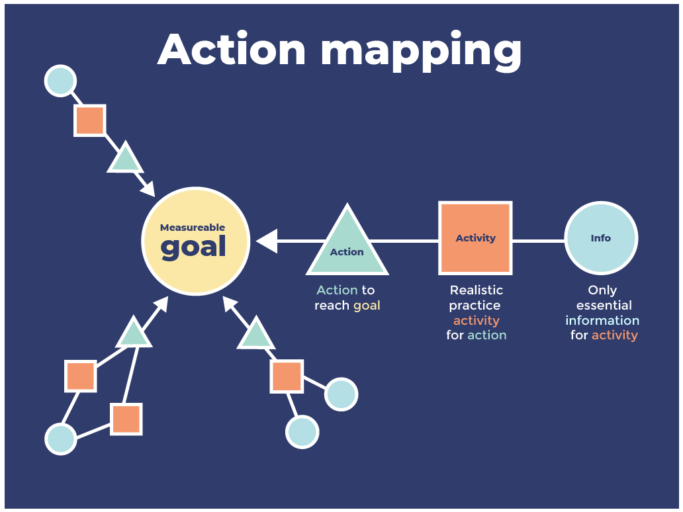Action mapping is a collaborative visual approach to eLearning design from Cathy Moore. It is used to kick off your learning projects, manage scope and provide direction for your design.
What is Action Mapping?
Action mapping focuses on what people do rather than what they might need to know. This focused approach places business goals and performance at the heart of the design process and aids the creation of learning activities that support learners achieving work-based performance targets.

Action mapping consists of four nodes:
- Measurable goal.
- Job behaviour or action that will reach the goal.
- Realistic practice activity for that behaviour.
- Essential information for that activity.
The content or information that usually makes up a large part of traditional eLearning is stripped away and only essential content is made available at the point of need. The model promotes the creation of activities that resemble common work situations that learners face and the required actions to take.
Why is Action Mapping useful to Instructional Designers?
The collaborative nature of an action mapping workshop has the benefit of getting early stakeholder and SME buy-in to the design process. The process can also reveal that eLearning might not be the optimum solution and a reference card or an environmental change (such as access to an online database) would lead to the desired performance improvement. Action mapping can also help with scope, ensuring only essential information that supports learner activity is included in the course.
How do you Execute Action Mapping?
An action mapping workshop is ideally undertaken during the project kick-off meeting:
- During a physical workshop, you will need a whiteboard and sticky notes. Alternatively, you can use an interactive digital model.
- Start with a measurable business goal with input from your stakeholder. The business goal sits in the middle of the model and everything extends from there.
- Then identify the actions that your learners must undertake to achieve the business goal from your stakeholder and SME.
- From the actions, start forming practice activities with your SME and identify the essential resources required to complete those activities (such as external job aids).
Once you have built the action map, you can start building rough prototypes of the activities and review with both the project team and your learners.
Review

Pros: Collaborative tool to get stakeholder buy-in to design; manage scope.
Cons: Stakeholder and SMEs resistance to participate in the workshop.
Related reading: CCAF, SAM, Instructional Design
